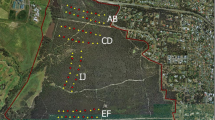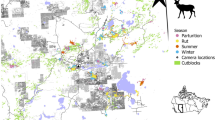Abstract
We examined how predator or prey presence, as well as local and landscape factors, influence the distribution of coyotes (Canis latrans) and white-tailed deer (Odocoileus virginianus) in the Chicago metropolitan area. We collected data for 2 years at 93 study sites along 3 transects of urbanization using motion-triggered cameras. Our primary objective was to determine the relationship among coyote and deer spatial and temporal distribution, habitat characteristics, and human activity using multi-season patch occupancy models. Coyote occupancy was most strongly linked to rates of site visitation by humans and dogs, and was more likely farther from the urban center, with coyote colonization of sites inversely related to road density, housing density, and human and dog site visitation. Deer more frequently occupied sites with high canopy cover near water sources and colonized smaller sites with reduced housing density and human and dog presence. Expected predator–prey dynamics were altered in this highly urban system. Though we predicted deer would avoid coyotes on the landscape based on an “ecology of fear” framework, deer and coyote occupancy showed a strong positive association. We suggest that a scarcity of quality habitat in urban areas may cause the species to co-occupy habitat despite potential fawn predation. Modifying human foot traffic in green spaces may represent a useful tool for management and conservation of large urban mammals.



Similar content being viewed by others
References
Atwood TC, Weeks HP, Gehring TM (2004) Spatial ecology of coyotes along a suburban-to-rural gradient. J Wildl Manage 68:1000–1009
Beier P, McCullough DR (1990) Factors influencing white-tailed deer activity patterns and habitat use. Wildlife Monogr 109:3–51
Bekoff M, Gese EM (2003) Coyote (Canis latrans). In: Feldhamer GA, Thompson BC, Chapman JA (eds) Wild mammals of North America: biology, management, and conservation, 2nd edition. Johns Hopkins University Press, Baltimore, pp 467–481
Brown JS, Kotler BP (2004) Hazardous duty pay and the foraging cost of predation. Ecol Lett 7:999–1014
Brown JS, Laundre JW, Gurung M (1999) The ecology of fear: optimal foraging, game theory, and trophic interactions. J Mammal 80:385–399
Burnham KP, Anderson DR (2002) Model selection and multimodel inference: a practical information-theoretic approach, 2nd edn. Springer, New York
Dearborn DC, Kark S (2010) Motivations for conserving urban biodiversity. Conserv Biol 24:432–440
Dill LM, Fraser AHG (1984) Risk of predation and the feeding behavior of juvenile coho salmon (Oncorhynchus kisutch). Behav Ecol Soc 16:65–71
ESRI (2009) ArcGIS desktop: release 9.3. Redlands, CA: Environmental Systems Research Institute
Etter DR, Hollis KM, Van Deelen TR, Ludwig DR, Chelsvig JE, Anchor CL, Warner RE (2002) Survival and movements of white-tailed deer in suburban Chicago, Illinois. J Wildlife Manage 66:500–510
Forman RTT (2008) The urban region: natural systems in our place, our nourishment, our home range, our future. Landscape Ecol 23:251–253
Forman RTT, Alexander LE (1998) Roads and their major ecological effects. Annu Rev Ecol Syst 29:207–231
Forman RTT, Sperling D, Bissonette JA, Clevenger AP, Cutshall CD et al (2003) Road ecology: science and solutions. Island Press, Washington DC, USA.
Frid A, Dill L (2002) Human-caused disturbance as aform of predation risk. Conserv Ecol 6:11
Gehrt SD (2007) Ecology of coyotes in urban landscapes. In: 12th Proc Wildl Damage Manage (2007), pp 303–311
Gehrt SD, Riley SPD (2010) Coyotes (Canis latrans). In: Gehrt SD, Riley SPD, Cypher BL (eds) Urban carnivores: ecology, conflict, and conservation. Johns Hopkins University Press, Baltimore, pp 79–95
Gehrt SD, Anchor C, White LA (2009) Home range and landscape use of coyotes in a metropolitan landscape: conflict or coexistence? J Mammal 90:1045–1057
Gehrt SD, Brown JL, Anchor C (2011) Is the urban coyote a misanthropic synanthrope? The case from Chicago. Cities Environ 4
George SL, Crooks KR (2006) Recreation and large mammal activity in an urban nature reserve. Biol Conserv 133:107–117
Grinder MI, Krausman PR (2001) Home range, habitat use, and nocturnal activity of coyotes in an urban environment. J Wildlife Manage 65:887–898
Grund MD, McAninch JB, Wiggers EP (2002) Seasonal movements and habitat use of female white-tailed deer associated with an urban park. J Wildlife Manage 66:123–130
Hines JE (2006) PRESENCE2. Software to estimate patch occupancy and related parameters. USGS-PWRC. (http://www.mbr-pwrc.usgs.gov/software/presence.html)
Kays RW, Gompper ME, Ray JC (2008) Landscape ecology of Eastern coyotes based on large-scale estimates of abundance. Ecol Appl 18:1014–1027
Kilpatrick HJ, Spohr SM (2000) Spatial and temporal use of a suburban landscape by female white-tailed deer. Wildlife Soc B 28:1023–1029
Lima SL (1998) Nonlethal effects in the ecology of predator–prey interactions. Bioscience 48:25–34
Lima SL, Valone TJ, Caraco T (1985) Foraging efficiency-predation-risk trade-off in the grey squirrel. Anim Behav 33:155–165
Lingle S (2001) Anti-Predator strategies and grouping patterns in white-tailed deer and mule deer. Ethology 107:295–314
Lingle S, Pellis S (2002) Fight or flight? Antipredator behavior and the escalation of coyote encounters with deer. Oecologia 131:154–164
MacArthur RH, Pianka ER (1966) On optimal use of a patchy environment. Am Nat 100:603–609
MacArthur RH, Wilson EO (1967) The theory of island biogeography. Princeton University Press, Princeton
MacKenzie DI, Nichols JD, Royle JA, Pollock KH, Bailey LL, Hines JE (2006) Occupancy estimation and modeling: inferring patterns and dynamics of species occurrence. Elsevier Academic Press, Burlington, MA, USA
Magle SB, Zhu J, Crooks KR (2005) Behavioral responses to repeated human intrusion in black-tailed prairie dogs (Cynomys ludovicianus). J Mammal 86:524–530
Magle SB, Reyes P, Zhu J, Crooks KR (2010) Extirpation, colonization, and habitat dynamics of a keystone species along an urban gradient. Biol Conserv 143:2146–2155
Magle SB, Hunt VM, Vernon M, Crooks KR (2012) Urban wildlife research: past, present, and future. Biol Conserv 155:23–32
Mayer P (2010) Urban ecosystems research joins mainstream ecology. Nature 467:153
McClennen N, Wigglesworth RR, Anderson SH, Wachob DG (2001) The effect of suburban and agricultural development on the activity patterns of coyotes (Canis latrans). Am Midland Nat 146:27–36
McDonnell MJ, Pickett STA (1990) Ecosystem structure and function along urban–rural gradients: an unexploited opportunity for ecology. Ecology 71:1232–1237
Morey PS, Gese EM, Gehrt S (2007) Spatial and temporal variation in the diet of coyotes in the Chicago metropolitan area. Am Midland Nat 158:147–161
Muhly TB, Semeniuk C, Massolo A, Hickman L, Musiana M (2011) Human activity helps prey win the predator–prey space race. PLoS One 6(3):e17050. doi:10.1371/journal.pone.0017050
Mysterud A, Òstbye E (1999) Cover as a habitat element for temperate ungulates: effects on habitat selection and demography. Wildlife Soc B 27:385–394
Nellis CH, Keith LB (1976) Population dynamics of coyotes in central Alberta, 1964–68. J Wildlife Manage 40:389–399
Ng JW, Nielsen C, St. Clair CC (2008) Landscape and traffic factors influencing deer-vehicle collisions in an urban environment. Human-Wildlife Conflicts 2:34–47
Nixon CM, Hansen LP, Brewer PA, Chelsvig JE (1991) Ecology of white-tailed deer in an intensively farmed region of Illinois. Wildl Monogr 118:1–77
Odell EA, Knight RL (2001) Songbird and medium-sized mammal communities associated with exurban development in Pitkin county, Colorado. Conserv Biol 15:1143–1150
Ordenana MA, Crooks KR, Boydston EE, Fisher RN, Lyren LM, Siudyla S, Haas CD, Harris S, Hathaway SA, Turschak GM, Miles AK, Van Vuren DH (2010) Effects of urbanization on carnivore species distribution and richness. J Mammal 91:1322–1331
Ozoga JJ, Harger EM (1966) Winter activities and feeding habits of Northern Michigan coyotes. J Wildlife Manage 30:809–818
Paul MJ, Meyer JL (2001) Streams in the urban landscape. Annu Rev Ecol Syst 32:333–365
Pauley GR, Peek JM, Zager P (1993) Predicting white-tailed deer habitat use in Northern Idaho. J Wildlife Manage 57:904–913
Piccolo BP, Van Deelen TR, Hollis-Etter K, Warner RE, Anchor C (2010) Behavior and survival of white-tailed deer neonates in two suburban forest preserves. Can J Zool 88:487–495
Porter WF, Underwood HB, Woodard JL (2004) Movement behavior, dispersal, and the potential for localized management of deer in a suburban environment. J Wildlife Manage 68:247–256
Quinn T (1995) Using public sighting information to investigate coyote use of urban habitat. J Wildlife Manage 59:238–245
Quinn T (1997) Coyote (Canis latrans) habitat selection in urban areas of Western Washington via analysis of routine movements. Northwest Science 71:289–297
Ramalho CE, Hobbs RJ (2012) Time for a change: dynamic urban ecology. Trends Ecol and Evol 27:179–188
Richmond OMW, Hines JE, Beissinger SR (2010) Two-species occupancy models: a new parameterization applied to co-occurrence of secretive rails. Ecol Appl 20:2036–2046
Riley SPD, Sauvajot RM, Fuller TK, York EC, Kamradt DA, Bromley C, Wayne RK (2003) Effects of urbanization and habitat fragmentation on bobcats and coyotes in Southern California. Conserv Biol 17:566–756
Slabbekorn H, Peet M (2003) Birds sing at a higher pitch in urban noise. Nature 424:267–267
Soulé ME, Bolger DT, Alberts AC, Sauvajot R, Wright J, Sorice M, Hill S (1988) Reconstructed dynamics of rapid extinctions of chaparral-requiring birds in urban habitat islands. Conserv Biol 2:75–92
Storm DJ, Nielsen CK, Schauber EM, Woolf A (2007) Space use and survival of white-tailed deer in an exurban landscape. J Wildlife Manage 71:1170–1176
Theobald DM, Miller JR, Hobbs NT (1997) Estimating the cumulative effects of development on wildlife habitat. Landscape Urban Plan 39:25–36
Vogel WO (1989) Response of deer to density and distribution of housing in Montana. Wildlife Soc B 17:406–413
Whittaker DG, Lindzey FG (1999) Effect of coyote predation on early fawn survival in sympatric deer species. Wildlife Soc B 27:256–262
Willingham AN (2008) Emerging factors associated with the decline of a gray fox population and multi-scale land cover associations of mesopredators in the Chicago metropolitan area. M.S. Thesis, The Ohio State University
Acknowledgments
We thank M. Fidino, H. Grant, M. Kestufskie, J. Kilgour, M. Vernon, and others for assistance with fieldwork. An anonymous reviewer provided comments that greatly improved the manuscript. We are grateful to the many landowners who allowed us access to their property, including the forest preserve districts of Cook, DuPage, Lake, and Will counties, the Illinois Department of Natural Resources’ Nature Preserve Commission, the Chicago Park District, and the Archdiocese of Chicago. Funding was provided by the University of Illinois at Chicago, the Lincoln Park Zoo, and the Davee Foundation.
Author information
Authors and Affiliations
Corresponding author
Rights and permissions
About this article
Cite this article
Magle, S.B., Simoni, L.S., Lehrer, E.W. et al. Urban predator–prey association: coyote and deer distributions in the Chicago metropolitan area. Urban Ecosyst 17, 875–891 (2014). https://doi.org/10.1007/s11252-014-0389-5
Published:
Issue Date:
DOI: https://doi.org/10.1007/s11252-014-0389-5




